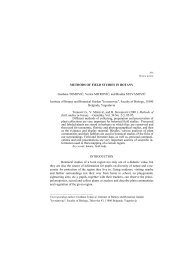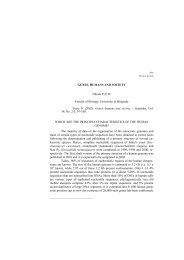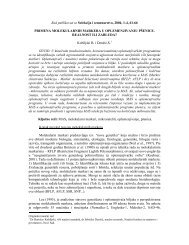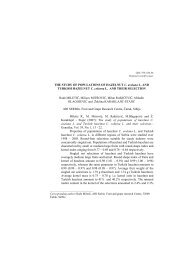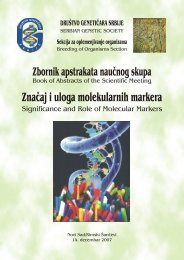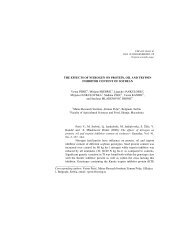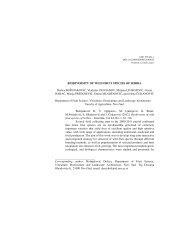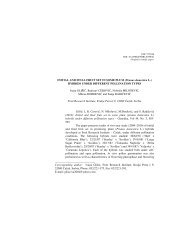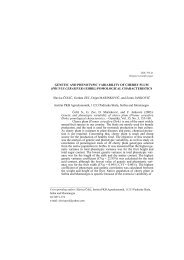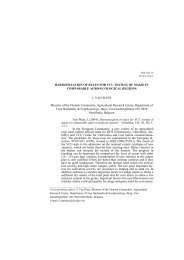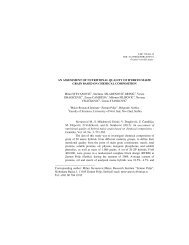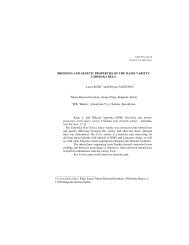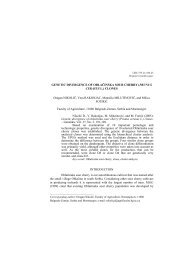Zbornik - Društvo genetičara Srbije
Zbornik - Društvo genetičara Srbije
Zbornik - Društvo genetičara Srbije
Create successful ePaper yourself
Turn your PDF publications into a flip-book with our unique Google optimized e-Paper software.
94 ZBORNIK ABSTRAKATA III KONGRESA GENETIÈARA SRBIJE IV-Usm-5<br />
Subotica, 30. novembar - 4. decembar 2004.<br />
ANALIZA DOMESTIFIKACIONOG SINDROMA CRNOG BORA<br />
NA PODRUÈJU SCG I BIH<br />
A. Tucoviæ 1 , M. Mataruga 2 i Mirjana Šijaèiæ-Nikoliæ 1<br />
1<br />
Šumarski fakultet, Beograd<br />
2<br />
Šumarski fakultet, Banja Luka<br />
Na osnovu istraivanja prirasta prirodnih, gajenih i oglednih stabala, moe se zakljuèiti<br />
da je crni bor, posebno u našim uslovima, vrsta èiji genetièki potencijal nije dovoljno<br />
upoznat, s tim ni dovoljno iskorišæen. Meðuprovenijenièna i unutarprovenijenièna<br />
promenljivost osobina uzoraka semena, jednogodišnjih i dvogodišnjih sadnica odgajenih<br />
na raznim supstratima u BIH, pokazuje da je unutarprovenijenièna varijabilnost veæa od<br />
meðuprovenijeniène varijabilnosti. Ekonomski znaèajana svojstva, npr. otpornost na<br />
sušu su kompleksnog karaktera i zavise od velikog broja osobina. Krupan doprinos je u<br />
razradi postupaka za izradu modela sadnica otpornih na sušu, uz postupani izbor<br />
znaèajnih parametara stanja vodnog reima.<br />
Izraen morfo-anatomski i fiziološki varijabilitet crnog bora uslovljen je visokim stepenom<br />
heterozigotnosti tj. specifiènom genetièkom strukturom lokalnih populacija i pripada tzv.<br />
ekstremnom balansnom tipu genetièke strukture njegovih populacija. Prema iznetoj<br />
hipotezi lokusi u hromozomima nisu zastupljeni dominantno-recesivnim alalima veæ<br />
brojnih serijama multipnih alela, što je jedna od osnova za bri i uspešniji rad na daljem<br />
oplemenjivanju vrste u funkciji proizvodnje kvalitetnog sadnog materijala i namenskih<br />
kultura ove vrste. Crni bor obezbeðuje znaèajne izvore korisnih informacija koje se odnose<br />
na prirodne i gajene sastojine, kao i onih koje se tièu funkcionisanja genetskih mehanizama,<br />
te ulazi u red vrsta pogodnih za izuèavanje tzv. domestifikacionog sindroma.<br />
ANALYSIS OF DOMESTICATION SYNDROME OF AUSTRIAN PINE IN THE<br />
AREA OF SERBIA AND MONTENEGRO AND BOSNIA AND HERZEGOVINA<br />
Based on the increment study of natural, cultivated and test trees, it can be concluded that<br />
Austrian pine, especially in our conditions, is the species whose genetic potential is not<br />
sufficiently elucidated, and also not sufficiently utilised. Inter- and intra-provenance<br />
variability of the characters of seed samples, one-year-old and two-year-old seedlings<br />
cultivated in different substrates in BIH, shows that intra-provenance variability is higher<br />
than inter-provenance variability. Economically significant properties, e.g. resistance to<br />
drought, are complex and depend on a great number of characters. A large contribution is<br />
the working out of the procedures for the development of the seedling model resistant to<br />
drought, with a gradual selection of the significant parameters of water regime conditions.<br />
A high morpho-anatomical and physiological variability of Austrian pine is conditioned<br />
by a high degree of heterozygosity, i.e. specific genetic structure of the local populations,<br />
and it belongs to the so-called extreme balance type of its population genetic structure.<br />
According to the hypothesis, the loci in the chromosomes are not represented by dominant-recessive<br />
alleles, but by numerous series of multiple alleles, which is one of the<br />
bases for the faster and more successful work on further improvement of species in the<br />
function of production of good quality planting material and specific purpose plantations.<br />
Austrian pine ensures significant sources of useful information referring to natural and<br />
cultivated stands and information on the function of genetic mechanisms, so it belongs to<br />
the species favourable for the study of the so-called domestication syndrome.



